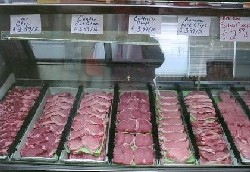Editor’s Note: This is the final installment of Kevin Wright’s insider view on growing produce for farmer’s markets and vegetable stands. See the first entry here: Snipped From The Market Garden 1 if you missed it.
 The Farmer’s Market
The Farmer’s Market
Depending on where you live it can be difficult to make any money at the local farmer’s market. The reason I say this is because there are so many vendors who are only there to try and make a few dollars off their surplus produce. Market gardeners like me are there to make a living. It’s hard to sell beans at $2.00 a pound when a vendor a few booths down is selling hers for $1.00 a pound. Yes, I understand that there will be competition in today’s tough economy.
So how do you compete? Market yourself. Show off. Make it clear that your produce has value above the asking price, and motivate the customer to buy it. Tell them why your produce is the best. I grow everything by using organic methods and I let people know that I use no chemicals, pesticides, or anything that hurts the environment. Folks will pay a little more for safe, wholesome produce.
At your farmer’s market stand have your produce displayed as beautifully as you can. Pile it high, use attractive baskets or containers. When you make your produce look like it’s special (it is!), you customers can see that, and know you mean business–and that you know your business too. Give the customer plenty of product to sort through so they can get the vegetables that look perfect to them. Educate them on how and what you grow and best of all, get to know their names. Personal contact gets people coming to you. Soon enough they will be as excited to see you each week as much as you look forward to seeing them.
Wholesale
I will always love the wholesale part of selling produce. Yes, your profit margin will be slimmer but once you make a sale to a distributor (which could be a single local store, a restaurant or even a grocery distributor) you know it is final. But by wholesaling you harvest only what you know you have already sold to the distributor. There’s no over-harvesting, which typically occurs when heading to the market, where you have to hope you have enough of seasonal produce, but not so much that  you’ll be carrying it home at the end of the day. At a farmer’s market you might get stuck with, say 15 pounds of greens at the end of a market day, and may only be suitable at that point for the chickens. There’s no danger of that with the wholesale model. You do have to find outlets, and that can take some time, but in the end, it may be the ideal way to handle your produce.
 Freelancing
Freelancing
What do I mean by freelancing? Simply, it’s approaching a local business and asking permission to set up a table once a week to sell your produce. Let them know you are a local grower. You will be surprised at how many will let you set up shop for a few hours a week. Because your time at the freelance location may be limited, make sure that you choose a location with good foot traffic, ideally where your customers would have to pass you to get to the store, activity or whatever.
Pricing can be difficult. That is why I make a weekly visit to the local grocery store and their produce department. Remember the store’s prices and then set yours. Don’t be afraid to be a little higher if need be-remember, your produce has a higher value! A customer may question your prices. Let them know nicely that you just picked your produce that very morning and it is at its freshest and that the grocery store probably picked theirs at least two weeks ago and it was shipped in from miles away. If it works for you, don’t be afraid to price lower than the grocery stores for that matter.
Last but not least I have one last tip for the would be market gardener:  Don’t be afraid to charge your family for your produce. You worked hard to get it to the market, don’t give it away for free!






























